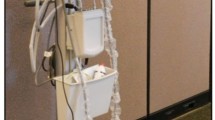Abstract
Axial vertebral rotation, an important parameter in the assessment of scoliosis may be identified on X-ray images. In line with the advances in the field of digital radiography, hospitals have been increasingly using this technique. The objective of the present study was to evaluate the reliability of computer-processed rotation measurements obtained from digital radiographs. A software program was therefore developed, which is able to digitally reproduce the methods of Perdriolle and Raimondi and to calculate semi-automatically the rotation degree of vertebra on digital radiographs. Three independent observers estimated vertebral rotation employing both the digital and the traditional manual methods. Compared to the traditional method, the digital assessment showed a 43% smaller error and a stronger correlation. In conclusion, the digital method seems to be reliable and enhance the accuracy and precision of vertebral rotation measurements.



Similar content being viewed by others
References
Braun JT, Akyuz E (2005) Prediction of curve progression in a goat scoliosis Model. J Spinal Disord Tech 18:272–276
Cobb JR (1948) Outline for the study of scoliosis. Instructional Course Lectures. J Am Acad Orthop Surg 5:261–275
Nash C, Moe JH (1969) A study of vertebral rotation. J Bone Joint Surg 51:223–229
Perdriolle R, Vidal J (1985) Thoracic idiopathic scoliosis curve evaluation and prognosis. Spine 10:785–791
Drerup B (1984) Principles of measurement of vertebral rotation from frontal projection of the pedicles. J Biomech 17:923–935
Stokes IAF, Bigalow LC, Moreland MS (1986) Measurement of axial rotation of vertebrae in scoliosis. Spine 11:213–218
Weiss HR (1995) Measurement of vertebral rotation: Perdriolle versus Raimondi. Eur Spine J 4:34–38
Ho EKW, Upadhyay SS, Ferris L, Chan FL, Shone JB, Hsu LCS et al (1992) A comparative study of computed tomographic and plain radiographic methods to measure vertebral rotation in adolescent idiopathic scoliosis. Spine 17:771–774
Yazici M, Acaroglu ER, Alanay A, Deviren V, Cila A, Surat A (2001) Measurement of vertebral rotation in standing versus supine position in adolescent idiopathic scoliosis. J Pediatr Orthop 21:252–256
Kushner DC, Cleveland RH, Herman TE, Zaleske DJ, Ehrlich MG, Correia JA (1986) Radiation dose reduction in the evaluation of scoliosis: an application of digital radiography. Radiology 161:175–181
Chi W, Cheng CW, Yeh WC, Chuang SC, Chang S, Chen JH (2006) Vertebral axial rotation measurement method. Comput Methods Programs Biomed 81:8–17
Göçen S, Havitçioglu H, Alici E (1999) A new method to measure vertebral rotation from CT scans. Eur Spine J 8(261–265):261–265
Molnár S, Manó S, Kiss L, Csernátony Z (2006) Ex vivo and in vitro determination of the axial rotational axis of the human thoracic spine. Spine 31:984–991
Hartley R, Zisserman A (2004) Multiple view geometry in computer vision. Cambridge Press, Massachusetts
Barsanti CM, De Bari A, Covino BM (1990) The torsion meter: a critical review. J Pediatr Orthop 10:527–531
Omeroglu H, Ozekin O, Bicimoglu A (1996) Measurement of vertebral rotation in idiopathic scoliosis using the Perdriolle torsionmeter: a clinical study on intraobserver and interobserver error. Eur Spine J 5:167–171
Richards BS (1992) Measurement error in assessment of vertebral rotation using the Perdriolle torsionmeter. Spine 17:513–517
Lam GC, Hill DL, Le LH, Raso JV, Lou EH (2008) Vertebral rotation measurement: a summary and comparison of common radiographic and CT methods. Scoliosis. doi:10.1186/1748-7161-3-16
Doi K (2007) Computer-aided diagnosis in medical imaging: historical review, current status and future potential. Comput Med Imaging Graphics 31:198–211
Acknowledgments
The authors are grateful to observers, Fernando Herrero, Maximiliano Porto Azevedo and Juan Javier for skillful measurements and to Dr. Marcelo Henrique Nogueira Barbosa and Dr. Helton Luiz Aparecido Defino for valuable suggestions. This project was financially supported by grants from São Paulo State Research Support Fund (FAPESP, process #2007/58120-0) and Brazilian Scientific Research Advisory Board (CNPq).
Author information
Authors and Affiliations
Corresponding author
Rights and permissions
About this article
Cite this article
Pinheiro, A.P., Tanure, M.C. & Oliveira, A.S. Validity and reliability of a computer method to estimate vertebral axial rotation from digital radiographs. Eur Spine J 19, 415–420 (2010). https://doi.org/10.1007/s00586-009-1186-3
Received:
Revised:
Accepted:
Published:
Issue Date:
DOI: https://doi.org/10.1007/s00586-009-1186-3




